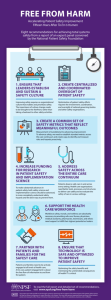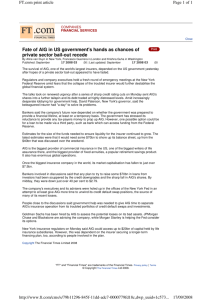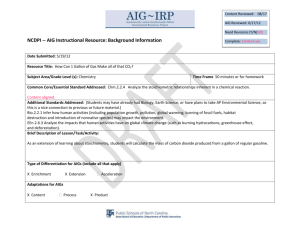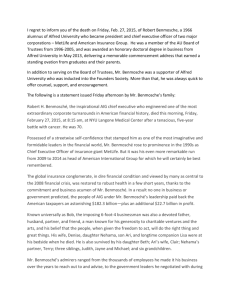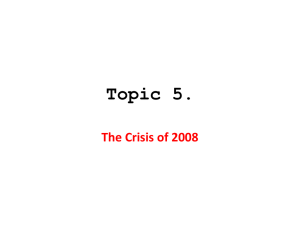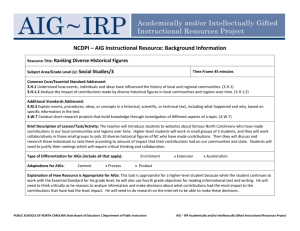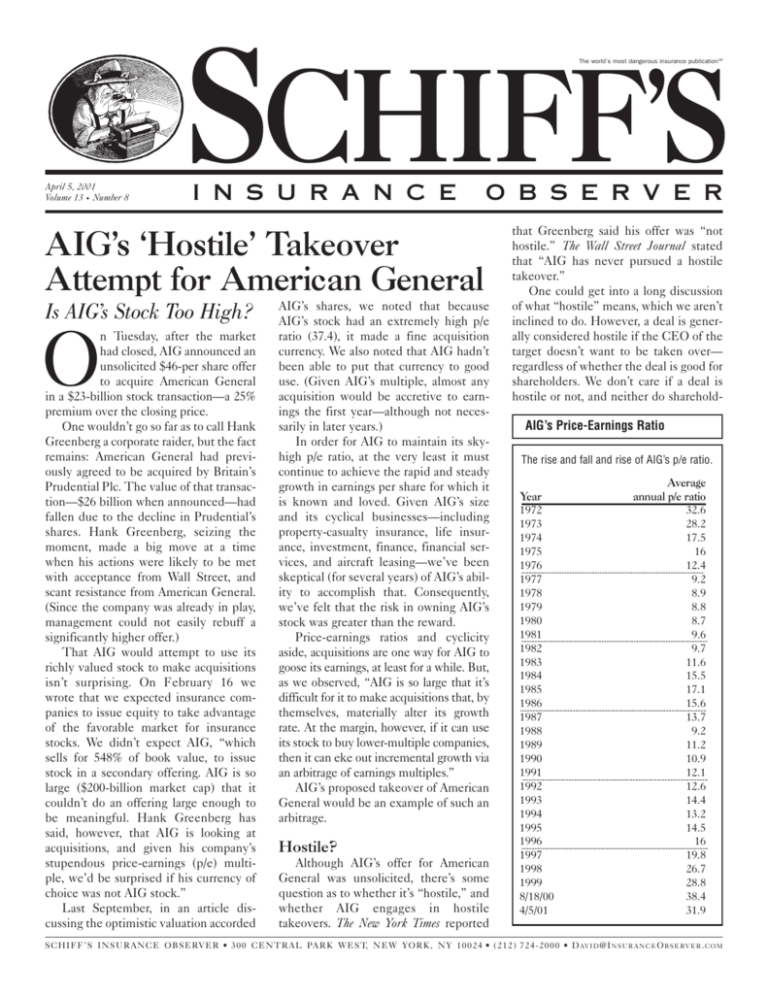
SCHIFF’S
The world’s most dangerous insurance publicationSM
April 5, 2001
Volume 13 • Number 8
I N S U R A N C E
O B S E R V E R
AIG’s ‘Hostile’ Takeover
Attempt for American General
Is AIG’s Stock Too High?
O
n Tuesday, after the market
had closed, AIG announced an
unsolicited $46-per share offer
to acquire American General
in a $23-billion stock transaction—a 25%
premium over the closing price.
One wouldn’t go so far as to call Hank
Greenberg a corporate raider, but the fact
remains: American General had previously agreed to be acquired by Britain’s
Prudential Plc. The value of that transaction—$26 billion when announced—had
fallen due to the decline in Prudential’s
shares. Hank Greenberg, seizing the
moment, made a big move at a time
when his actions were likely to be met
with acceptance from Wall Street, and
scant resistance from American General.
(Since the company was already in play,
management could not easily rebuff a
significantly higher offer.)
That AIG would attempt to use its
richly valued stock to make acquisitions
isn’t surprising. On February 16 we
wrote that we expected insurance companies to issue equity to take advantage
of the favorable market for insurance
stocks. We didn’t expect AIG, “which
sells for 548% of book value, to issue
stock in a secondary offering. AIG is so
large ($200-billion market cap) that it
couldn’t do an offering large enough to
be meaningful. Hank Greenberg has
said, however, that AIG is looking at
acquisitions, and given his company’s
stupendous price-earnings (p/e) multiple, we’d be surprised if his currency of
choice was not AIG stock.”
Last September, in an article discussing the optimistic valuation accorded
AIG’s shares, we noted that because
AIG’s stock had an extremely high p/e
ratio (37.4), it made a fine acquisition
currency. We also noted that AIG hadn’t
been able to put that currency to good
use. (Given AIG’s multiple, almost any
acquisition would be accretive to earnings the first year—although not necessarily in later years.)
In order for AIG to maintain its skyhigh p/e ratio, at the very least it must
continue to achieve the rapid and steady
growth in earnings per share for which it
is known and loved. Given AIG’s size
and its cyclical businesses—including
property-casualty insurance, life insurance, investment, finance, financial services, and aircraft leasing—we’ve been
skeptical (for several years) of AIG’s ability to accomplish that. Consequently,
we’ve felt that the risk in owning AIG’s
stock was greater than the reward.
Price-earnings ratios and cyclicity
aside, acquisitions are one way for AIG to
goose its earnings, at least for a while. But,
as we observed, “AIG is so large that it’s
difficult for it to make acquisitions that, by
themselves, materially alter its growth
rate. At the margin, however, if it can use
its stock to buy lower-multiple companies,
then it can eke out incremental growth via
an arbitrage of earnings multiples.”
AIG’s proposed takeover of American
General would be an example of such an
arbitrage.
Hostile?
Although AIG’s offer for American
General was unsolicited, there’s some
question as to whether it’s “hostile,” and
whether AIG engages in hostile
takeovers. The New York Times reported
that Greenberg said his offer was “not
hostile.” The Wall Street Journal stated
that “AIG has never pursued a hostile
takeover.”
One could get into a long discussion
of what “hostile” means, which we aren’t
inclined to do. However, a deal is generally considered hostile if the CEO of the
target doesn’t want to be taken over—
regardless of whether the deal is good for
shareholders. We don’t care if a deal is
hostile or not, and neither do shareholdAIG’s Price-Earnings Ratio
The rise and fall and rise of AIG’s p/e ratio.
Year
1972
1973
1974
1975
1976
1977
1978
1979
1980
1981
1982
1983
1984
1985
1986
1987
1988
1989
1990
1991
1992
1993
1994
1995
1996
1997
1998
1999
8/18/00
4/5/01
Average
annual p/e ratio
32.6
28.2
17.5
16
12.4
9.2
8.9
8.8
8.7
9.6
9.7
11.6
15.5
17.1
15.6
13.7
9.2
11.2
10.9
12.1
12.6
14.4
13.2
14.5
16
19.8
26.7
28.8
38.4
31.9
SCHIFF’S INSURANCE OBSERVER • 300 CENTRAL PARK WEST, NEW YORK, NY 10024 • (212) 724-2000 • D AV I D @I N S U R A N C E O B S E RV E R . C O M
ble” appeared in articles during
ers. They generally care about which
E-Madness: Internet vs. Insurance—An Update
March. The number—1,710—was
deal gives them the best value.
sizable, apparently demonstrating
Whether AIG engages in “hos- Market caps of various companies, in billions of dollars.
that reporters are good at identifying
tile” deals, however, is a subject
a stock-market bubble after it has
worth a few paragraphs. For exam- Internet
12/10/99 01/14/00 10/13/00 04/04/01
burst. (In March 1999, for instance,
ple, AIG has been gradually increas- America Online $205
$141
$123
$155*
these words appeared one-third as
ing its ownership in 21st Century Yahoo
93
93
33
7
often as they did this past March.)
Insurance, and now has 63% of the Amazon
36
22
10
3
Although we labeled “Internetcompany. Shareholders might right- CMGI
23
30
5
0.65
stock mania” a “speculative bubble”
ly view AIG’s accumulation as a
21
17
15
8.2
in our March 1999 issue, we didn’t
“creeping takeover”—one in which eBay
9
7
4
1.8
profess to know when it would end,
it gains control without paying the E*Trade
1
0.7
0.06
0.04
even though we had thoughts about
control premium that a tender offer InsWeb
0.2
0.2
0.03
0.006 how it would end. As we wrote,
for the entire company would neces- Quotesmith
sitate.
Insurance 12/10/99 01/14/00 10/13/00 04/04/01 “Whether one chooses to call the
current U.S. economic environment
AIG has also struck fear in the AIG
$172
$177
$214
$179
a boom, bubble, bull market, or new
hearts of insurance companies in the Marsh & McLennan 24
28
32
25
era, it will, in all likelihood, be folpast. In 1974, American Reinsurance Allstate
22
19
24
30
lowed by what will be known as a
filed suit to prevent AIG from buying Cigna
15
15
18
16
bust, bear market, recession, or
more than 9.9% of American Re’s
10
10
16
14
depression.”
stock. In 1979, Mission Insurance Hartford
9
10
13
12
While our call was accurate, it
Group rejected an unsolicited merger Chubb
6
5
5
7
wasn’t necessarily something one
offer from AIG (which then owned Progressive
0.6
0.5
0.8
1.3
could profit from. Indeed, the price
4.5% of Mission), stating that the W. R. Berkley
of Internet and tech stocks contindeal was “not in the best interest of *Valuation is after stock merger with Time Warner
ued to rise sharply for the next 12
Mission and its stockholders.”
licenses in many states—the approval of
months.
(Mission was wrong.)
each state’s regulator is generally
In December 1999 we noted that
In 1981, AIG disclosed that it had
required. A hostile insurance takeover is
Yahoo’s market cap—then $93 billion—
acquired 8.53% of USLife, prompting
time consuming, and the regulatory roadwas equal to those of Marsh & McLennan,
that company’s chairman, Gordon
blocks can make a deal impossible.
Allstate, Cigna, Hartford, Chubb, St. Paul,
Crosby, to state that USLife’s board was
Allegheny, for example, was unable to
and Progressive combined.
opposed to any attempt to take over the
take over St. Paul.)
Things have changed. Yahoo is now
company, and that it was in USLife’s best
A final thought: Greenberg had
valued at $7 billion, while the insurance
interest to remain independent. In 1982,
breakfast with American General’s CEO,
companies are worth $25 billion, $30 bilAIG sold its USLife shares back to
Robert Devlin, six months ago and,
lion, $16 billion, $14 billion, $12 billion,
USLife. (In 1997, USLife was acquired
according to Greenberg, there was sup$9 billion, and $7 billion, respectively, or
by American General in an all-stock
posed to be some follow-up, but it never
a total of $113 billion.
transaction.)
occurred. One presumes that if Devlin
How could Yahoo, which had $1.1 bilIn 1983, AIG bought 8% of
had wanted AIG to acquire American
lion in revenues in 2000, ever carry a $93
Progressive and was planning to purGeneral, then he’d have picked up the
billion valuation? (Indeed, one must make
chase a 12.3% stake held by American
phone and asked Greenberg to make a
very optimistic assumptions to justify the
Financial. This threat prompted a group
bid.
company’s current valuation.) The answer
of Progressive shareholders who held a
Anyway, Hank Greenberg is a genius,
is that Yahoo’s valuation was wildly specu39% interest in the company to form a
and if he says that his unsolicited offer to
lative, and represented investors’ frenzied
bloc opposing AIG’s accumulation of
buy American General isn’t “hostile,”
and unwarranted optimism about the
Progressive shares. As a result, AIG canthen who are we to disagree?
company’s long-term prospects. Yahoo was
celled its agreement to buy American
priced for permanent perfection, and
Financial’s 12.3% stake, and American
when that didn’t materialize, its absurd p/e
Financial subsequently sold these shares
Thoughts on Speculation
ratio gave the company a long way to fall
back to Progressive.
Before discussing this deal further, we
before it would be priced rationally. As
The American Re, Mission, USLife,
want to step back and examine the curJames Grant, editor of the marvelous
and Progressive situations differed from
rent stock-market environment, speculaGrant’s Interest Rate Observer recently
that of American General in at least one
tion, and p/e multiples, because these
wrote, “Booms don’t last forever: they are
respect: none of those companies was
affect AIG’s ability to complete a deal,
cut short by their own excesses…
already “in play,” and AIG would have
and because they’re driving forces in the
However, busts, too, generate excesses
had considerable difficulty accomplishindustry.
that tend to hasten cyclical reversals, or at
ing a takeover that was unwanted by
We conducted a Dow Jones News
least to exaggerate their magnitude once
those companies. (In order to acquire an
Retrieval search to see how many times
they start.”
continued
insurance company—especially one with
the words “stock,” “market,” and “bub2
APRIL 5, 2001
SCHIFF’S INSURANCE OBSERVER ~ (212) 724-2000
We bring up Yahoo not just because
we’ve written about it in the past, but
because it’s a good example of an
extreme. Financial history is filled with
companies that sported wildly high valuations during periods of mass euphoria,
and depressed valuations (or no valuation) during the ensuing busts.
The boom-and-bust cycle isn’t limited to technology stocks—over the years
it has embraced virtually every industry,
from automobiles, oil & gas, telephones,
utilities, and conglomerates, to electronics, specialty retail, entertainment,
restaurants, finance, and, yes, insurance.
All of which brings us back to AIG.
We first expressed concern about the
company’s p/e and price-to-book ratio
back in October 1998 when its stock
price was $49—$27 lower than it is now.
We revisited the subject in our
September 2000 issue, when AIG’s stock
was $86. Although AIG’s excellent
record of earnings growth is one of the
factors in its stock’s superior returns, it
isn’t the only factor. AIG’s p/e ratio has
been in a long-term bull market of its
own; more than quadrupling since its
bottom in 1979.
A recent Merrill Lynch study
showed that since 1980, AIG’s average
p/e ratio based on forward consensus estimates has been 13.8. The lowest p/e
ratio—6.8—was recorded in June 1982,
and the highest—35.1—occurred in
December 2000. Perhaps coincidentally, AIG’s average p/e, according to the
Merrill study, is not very different from
the S&P 500’s average p/e over the last
129 years—14.5.
If one can infer anything about valuations from the past it is this: they fluctuate considerably. In 1929, for example,
the Dow Jones Industrial Average
(DJIA) was priced at 4.5 times book
The world’s most dangerous insurance publicationSM
SCHIFF’S
I N S U R A N C E
O B S E R V E R
Editor and Writer . . . . . . . . . . . David Schiff
Copy Editor. . . . . . . . . . . . . . . . . John Cauman
Editorial Associate . . . . . . . . . . Isaac Schwartz
Production Editor . . . . . . . . . . . . . . Bill Lauck
Publisher . . . . . . . . . . . . . . . . Alan Zimmerman
Customer Service Director . . . . . . Pat LaBua
Advertising Manager . . . . . . . . . Mark Outlaw
© 2001, Insurance Communications Co., LLC.
All rights reserved.
SCHIFF’S INSURANCE OBSERVER ~ (212) 724-2000
value. Three years later, when the DJIA
hit its all-time low, it was valued at onehalf of book. (The p/e ratio wasn’t meaningful in 1932, as the companies in the
DJIA lost money.)
Although the S&P 500’s p/e ratio has
averaged 14.5 over the long term, stocks
have often traded way above, or way
below, that figure. Valuations, however,
have historically reverted to the mean,
and then some. Every period in which
stocks have traded in excess of a 14.5
multiple has been followed by a period
in which valuations fell well below that
figure. History, of course is just a guide,
not a blueprint for the future. The past
does not have to repeat itself.
Thus, the history of AIG’s valuation
doesn’t foretell how AIG’s stock will be
valued in the future. Nonetheless, the
past is still worth considering. In 1972,
AIG’s p/e ratio was 32.6—about what it is
today. Despite the fact that AIG’s earnings continued to rise steadily, AIG’s
shares lost two-thirds of their value over
the next two years, and AIG’s stock price
didn’t get back to its 1972 high until
1978—even though earnings had
quadrupled and book value had tripled
during that period.
AIG is a great company, but there’s
considerable risk in owning a financial-services company selling for 32
times earnings. AIG’s high valuation
leaves little room for error or disappointment.
In order for AIG’s shares to appreciate, two things must happen: earnings
per share must grow, and the p/e ratio
must remain the same or go higher.
Steadily rising earnings per share are
essential because investors, in anticipation of such, have bid up AIG’s stock to
an extreme p/e ratio, which, of course,
facilitates AIG’s use of its stock to
Editorial Office
Schiff’s Insurance Observer
300 Central Park West, Suite 4H
New York, NY 10024
Phone: (212) 724-2000
Fax: (212) 712-1999
E-mail: David@InsuranceObserver.com
Publishing Headquarters
Schiff’s Insurance Observer
SNL c/o Insurance Communications Co.
321 East Main Street
P.O. Box 2056
Charlottesville, VA 22902
Phone: (804) 977-5877
Fax: (804) 984-8020
E-mail: Subscriptions@InsuranceObserver.com
acquire lower-multiple companies, thus
providing a boost to earnings per share.
As AIG gets larger—and it is already
huge—greater than average growth
becomes more difficult.
While it’s wise for AIG to use its highmultiple stock to make acquisitions, one
concerned with security analysis must
ask a basic question: if AIG, which trades
at 32 times earnings, buys American
General for 18 times earnings, should
AIG’s 32 multiple be applied to
American General’s supposedly lowergrowth business once that business
becomes part of AIG? According to
Greenberg, the answer is yes. At yesterday’s conference call he spoke of crossmarketing and cost savings, and said,
“I’m comfortable that two and two here
will make five, if not seven.”
In the 1960s, under the guise of “synergy”—a 2+2=5 equation—conglomerates, which had staggeringly high p/e
ratios, acquired diverse, lower-multiple
businesses including bakeries, foundries,
machine shops, and insurance companies. For a while, the market was willing
to apply the conglomerates’ high p/e
multiples to the earnings acquired from
the acquisition of slower-growth businesses. Eventually, however, the merrygo-round came to a halt.
In theory, AIG—or any business with
a high p/e ratio—can be a perpetual
growth machine by endlessly performing
the arbitrage of using its high p/e stock to
acquire earnings that are selling at a
lower p/e. In practice, this is difficult to
do, and, of course, is dependant upon,
among other things, always having a high
p/e multiple.
Investors in AIG would do well to
remember that AIG, which traded at 32.6
times earnings in 1972, traded at 8.7
times earnings in 1980, 9.2 times earnings in 1988, and 13.2 times earnings in
1994.
Although Yahoo traded at 100 times
revenues last year, we doubt that AIG’s
p/e ratio has much room for expansion.
Absent any change in the p/e,
investors’ returns will mirror AIG’s
growth, which many analysts peg at
about 15% annually.
If that growth fails to materialize for
some reason—or if earnings actually
decline, as they did in 1984—it’s a safe
bet that AIG will trade at a much lower
multiple.
APRIL 5, 2001
3

